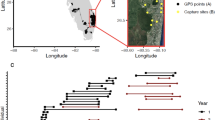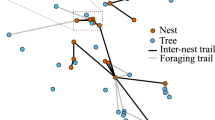Abstract
Efficient and robust transportation networks are key to the effectiveness of many natural systems. In polydomous ant colonies, which consist of two or more spatially separated but socially connected nests, resources must be transported between nests. In this study, we analyse the network structure of the inter-nest trails formed by natural polydomous ant colonies. In contrast to previous laboratory studies, the natural colonies in our study do not form minimum spanning tree networks. Instead the networks contain extra connections, suggesting that in natural colonies, robustness may be an important factor in network construction. Spatial analysis shows that nests are randomly distributed within the colony boundary and we find nests are most likely to connect to their nearest neighbours. However, the network structure is not entirely determined by spatial associations. By showing that the networks do not minimise total trail length and are not determined only by spatial associations, the results suggest that the inter-nest networks produced by ant colonies are influenced by previously unconsidered factors. We show that the transportation networks of polydomous ant colonies balance trail costs with the construction of networks that enable efficient transportation of resources. These networks therefore provide excellent examples of effective biological transport networks which may provide insight into the design and management of transportation systems.


Similar content being viewed by others
References
Andersen AN, Patel AD (1994) Meat ants as dominant members of Australian ant communities: an experimental test of their influence on the foraging success and forager abundance of other species. Oecologia 98:15–24. doi:10.1007/bf00326085
Aron S, Deneubourg JL, Goss S, Pasteels JM (1990) Functional self-organisation illustrated by internest traffic in ants: the case of the argentine ant. In: Alt W, Hoffman G (eds) Biological motion. Springer, Berlin, pp 533–547
Baddeley A, Turner R (2005) Spatstat: an R package for analyzing spatial point patterns. J Stat Softw 12:1–42
Bebber DP, Hynes J, Darrah PR, Boddy L, Fricker MD (2007) Biological solutions to transport network design. Proc R Soc B Biol Sci 274:2307
Beekman M, Sumpter DJT, Ratnieks FLW (2001) Phase transition between disordered and ordered foraging in Pharaoh's ants. Proc Natl Acad Sci U S A 98:9703–9706. doi:10.1073/pnas.161285298
Boccaletti S, Latora V, Moreno Y, Chavez M, Hwang DU (2006) Complex networks: structure and dynamics. Phys Rep 424:175–308
Bonnet E, Peer YV (2002) zt: a software tool for simple and partial Mantel tests. J Stat Softw 7:1–12
Boudjema G, Lemperiere G, Deschamps-Cottin M, George Molland D (2006) Analysis and nonlinear modeling of the mound-building ant Formica lugubris spatial multi-scale dynamic in a larch-tree stand of the southern French Alps. Ecol Model 190:147–158
Buczkowski G, Bennett G (2008) Seasonal polydomy in a polygynous supercolony of the odorous house ant, Tapinoma sessile. Ecol Entomol 33:780–788. doi:10.1111/j.1365-2311.2008.01034.x
Buhl J, Gautrais J, Solé RV, Kuntz P, Valverde S, Deneubourg JL, Theraulaz G (2004) Efficiency and robustness in ant networks of galleries. Eur Phys J B Condens Matter Complex Syst 42:123–129
Buhl J, Gautrais J, Reeves N, Solé RV, Valverde S, Kuntz P, Theraulaz G (2006) Topological patterns in street networks of self-organized urban settlements. Eur Phys J B Condens Matter Complex Syst 49:513–522. doi:10.1140/epjb/e2006-00085-1
Buhl J, Hicks K, Miller E, Persey S, Alinvi O, Sumpter D (2009) Shape and efficiency of wood ant foraging networks. Behav Ecol Sociobiol 63:451–460. doi:10.1007/s00265-008-0680-7
Cerda X, Retana J, Haro A (1994) Social carrying between nests in polycalic colonies of the monogynoun ant Cataglyphis iberica (Hymenoptera: Formicidae). Sociobiology 23(3):215–231
Cerdá X, Dahbi A, Retana J (2002) Spatial patterns, temporal variability, and the role of multi-nest colonies in a monogynous Spanish desert ant. Ecol Entomol 27:7–15. doi:10.1046/j.0307-6946.2001.00386.x
Cherix D (1980) Note preliminaire sur la structure, la phenologie et le regime alimentaire d'une super-colonie de Formica lugubris Zett. Insect Soc 27:226–236
Cook Z, Franks DW, Robinson EJH (2013) Exploration versus exploitation in polydomous ant colonies. J Theor Biol 323:49–56. doi:10.1016/j.jtbi.2013.01.022
Csardi G, Nepusz T (2006) The igraph software package for complex network research. InterJournal Complex Systems: 1695
Dahbi A, Lenoir A (1998) Nest separation and the dynamics of the Gestalt odor in the polydomous ant Cataglyphis iberica (Hymenoptera, Formicidae). Behav Ecol Sociobiol 42:349–355
Debout G, Schatz B, Elias M, McKey D (2007) Polydomy in ants: what we know, what we think we know, and what remains to be done. Biol J Linn Soc 90:319–348
Dillier FX, Wehner R (2004) Spatio-temporal patterns of colony distribution in monodomous and polydomous species of North African desert ants, genus Cataglyphis. Insect Soc 51:186–196
Elias M, Rosengren R, Sundstrom L (2005) Seasonal polydomy and unicoloniality in a polygynous population of the red wood ant Formica truncorum. Behav Ecol Sociobiol 57:339–349. doi:10.1007/s00265-004-0864-8
Federle W, Maschwitz U, Fiala B (1998) The two-partner ant-plant system of Camponotus (Colobopsis) sp. 1 and Macaranga puncticulata (Euphorbiaceae): natural history of the exceptional ant partner. Insect Soc 45:1–16. doi:10.1007/s000400050064
Gastner MT, Newman MEJ (2006a) Shape and efficiency in spatial distribution networks. J Stat Mech Theory Exp 2006, P01015
Gastner MT, Newman MEJ (2006b) The spatial structure of networks. Eur Phys J B Condens Matter Complex Syst 49:247–252. doi:10.1140/epjb/e2006-00046-8
Guimera R, Mossa S, Turtschi A, Amaral LAN (2005) The worldwide air transportation network: anomalous centrality, community structure, and cities' global roles. Proc Natl Acad Sci 102:7794–7799
Heller NE, Gordon DM (2006) Seasonal spatial dynamics and causes of nest movement in colonies of the invasive Argentine ant (Linepithema humile). Ecol Entomol 31:499–510. doi:10.1111/j.1365-2311.2006.00806.x
Heller NE, Ingram KK, Gordon DM (2008) Nest connectivity and colony structure in unicolonial Argentine ants. Insect Soc 55:397–403. doi:10.1007/s00040-008-1019-0
Herbers JM (1986) Nest site limitation and facultative polygyny in the ant Leptothorax longispinosus. Behav Ecol Sociobiol 19:115–122. doi:10.1007/bf00299946
Herbers JM (1989) Community structure in north temperate ants: temporal and spatial variation. Oecologia 81:201–211. doi:10.1007/bf00379807
Holt J (1990) Observations on the relationships between meat ants and termites in tropical Australia. J Trop Ecol 6:379–382
Holway DA, Case TJ (2000) Mechanisms of dispersed central-place foraging in polydomous colonies of the Argentine ant. Anim Behav 59:433–441
Katifori E, Szöllősi GJ, Magnasco MO (2010) Damage and fluctuations induce loops in optimal transport networks. Phys Rev Lett 104:048704
Latora V, Marchiori M (2001) Efficient behavior of small-world networks. Phys Rev Lett 87:198701
Latora V, Marchiori M (2002) Is the Boston subway a small-world network? Phys A Stat Mech Appl 314:109–113. doi:10.1016/s0378-4371(02)01089-0
Latty T, Ramsch K, Ito K, Nakagaki T, Sumpter DJT, Middendorf M, Beekman M (2011) Structure and formation of ant transportation networks. J R Soc Interface 8:1298–1306
McIver JD (1991) Dispersed central place foraging in Australian meat ants. Insect Soc 38:129–137. doi:10.1007/bf01240963
Nakagaki T, Yamada H, Hara M (2004) Smart network solutions in an amoeboid organism. Biophys Chem 107:1–5. doi:10.1016/s0301-4622(03)00189-3
Perna A, Valverde S, Gautrais J, Jost C, Solé R, Kuntz P, Theraulaz G (2008) Topological efficiency in three-dimensional gallery networks of termite nests. Phys A Stat Mech Appl 387:6235–6244
Pfeiffer M, Linsenmair KE (1998) Polydomy and the organization of foraging in a colony of the Malaysian giant ant Camponotus gigas (Hym./Form.). Oecologia 117:579–590
Pfeiffer M, Linsenmair K (2000) Contributions to the life history of the Malaysian giant ant Camponotus gigas (Hymenoptera, Formicidae). Insect Soc 47:123–132
R Development Core Team (2011) R: A language and environment for statistical computing. R Foundation for Statistical Computing, Vienna
Rasband WS (1997–2012) ImageJ. U.S. National Institutes of Health: Bethesda, MD, USA
Ripley BD (1976) The second-order analysis of stationary point processes. J App Prob 13:255–266
Ripley BD, Rasson JP (1977) Finding the edge of a Poisson forest. J Appl Probab 14:483–491
Robinson EJH, Richardson T, Sendova-Franks A, Feinerman O, Franks N (2009) Radio tagging reveals the roles of corpulence, experience and social information in ant decision making. Behav Ecol Sociobiol 63:627–636. doi:10.1007/s00265-008-0696-z
Santini G, Ramsay PM, Tucci L, Ottonetti L, Frizzi F (2011) Spatial patterns of the ant Crematogaster scutellaris in a model ecosystem. Ecol Entomol 36:625–634. doi:10.1111/j.1365-2311.2011.01306.x
Sen P, Dasgupta S, Chatterjee A, Sreeram PA, Mukherjee G, Manna SS (2003) Small-world properties of the Indian railway network. Phys Rev E 67:036106
Snyder LE, Herbers JM (1991) Polydomy and sexual allocation ratios in the ant Myrmica punctiventris. Behav Ecol Sociobiol 28:409–415
Southworth D, He XH, Swenson W, Bledsoe C, Horwath W (2005) Application of network theory to potential mycorrhizal networks. Mycorrhiza 15:589–595
Tero A, Takagi S, Saigusa T, Ito K, Bebber DP, Fricker MD, Yumiki K, Kobayashi R, Nakagaki T (2010) Rules for biologically inspired adaptive network design. Sci Signal 327:439
Traniello JFA, Levings SC (1986) Intra- and intercolony patterns of nest dispersion in the ant Lasius neoniger: correlations with territoriality and foraging ecology. Oecologia 69:413–419
van Wilgenburg E, Elgar M (2007) Colony structure and spatial distribution of food resources in the polydomous meat ant Iridomyrmex purpureus. Insect Soc 54:5–10. doi:10.1007/s00040-007-0903-3
Wiernasz DC, Cole BJ (1995) Spatial distribution of Pogonomyrmex occidentalis: recruitment, mortality and overdispersion. J Anim Ecol 64:519–527
Acknowledgments
The authors would like to thank the anonymous reviewers for their constructive comments on the manuscript. Z Cook is supported by a NERC studentship. EJH Robinson acknowledges funding from the Royal Society.
Author information
Authors and Affiliations
Corresponding author
Additional information
Communicated by D. Naug
Electronic supplementary material
Below is the link to the electronic supplementary material.
ESM 1
PDF 303 kb
Rights and permissions
About this article
Cite this article
Cook, Z., Franks, D.W. & Robinson, E.J.H. Efficiency and robustness of ant colony transportation networks. Behav Ecol Sociobiol 68, 509–517 (2014). https://doi.org/10.1007/s00265-013-1665-8
Received:
Revised:
Accepted:
Published:
Issue Date:
DOI: https://doi.org/10.1007/s00265-013-1665-8




